Vultures play a crucial role in the ecosystems of Texas, serving as nature’s efficient cleanup crew.
These fascinating birds, including the Black and Turkey Vulture, contribute significantly to maintaining ecological balance by scavenging carrion.
In the vast landscapes of Texas, these airborne janitors play a vital role in waste management, preventing the spread of diseases and ensuring the efficient recycling of organic matter.
This exploration delves into the lives of these remarkable scavengers, examining their unique characteristics, ecological importance, and the preservation efforts necessary to safeguard their populations in the Lone Star State.
Join us on a journey through the skies of Texas to understand the significance of vultures and their intricate role in nature’s delicate tapestry.
Why Are There Not So Many Species of Vultures in Texas?
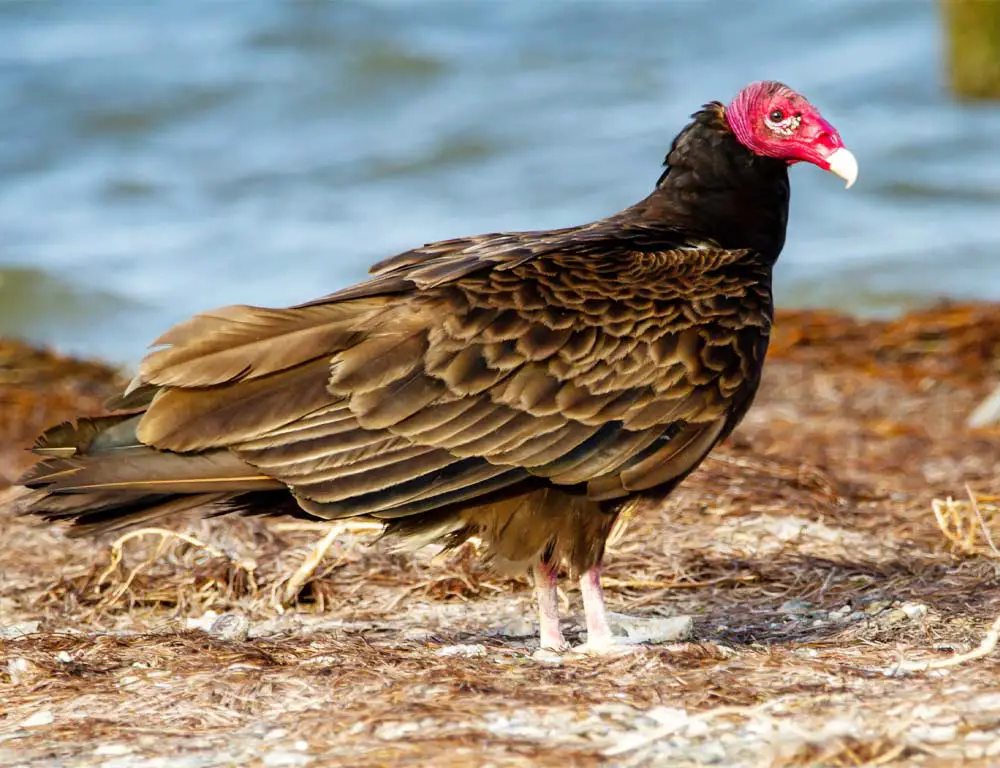
The diversity and abundance of vulture species in any given region can be influenced by several factors, and in the case of Texas, several reasons contribute to the relatively low number of vulture species:
Habitat Variation
Texas has diverse ecosystems, from deserts and grasslands to forests and coastal areas. Different vulture species have specific habitat preferences.
While some vultures thrive in open landscapes, others may prefer forested or coastal environments. The varied habitat in Texas may not be optimal for supporting a high diversity of vulture species.
Geographic Location
Texas is situated at the crossroads of different biogeographic regions. Vulture species may have more concentrated populations in specific regions, and Texas may not be a primary habitat for certain species.
Competition with Other Scavengers
Texas has other scavengers like eagles, hawks, and various carnivorous mammals that share the same ecological niche. Competition for food resources could limit the number of vulture species that can coexist in a given area.
Climate and Food Availability
Food availability often influences vulture species, and different species may have varying dietary preferences.
The arid or semi-arid conditions in parts of Texas may affect the abundance of carrion, a primary food source for vultures.
Human Impact
Human activities, including habitat destruction, poisoning, and vehicle collisions, can negatively impact vulture populations. Such anthropogenic factors can limit the presence of vultures in certain areas.
While Texas may not host many vulture species, it is home to the Turkey Vulture (Cathartes aura) and the Black Vulture (Coragyps atratus), which are commonly found in the state.
These vultures play crucial roles in ecosystem health by scavenging and helping to control disease by consuming carrion.
It’s essential to consider the complex interactions of ecological, environmental, and human factors when examining the distribution and abundance of species in any given region.
Common Characteristics of Vultures in Texas
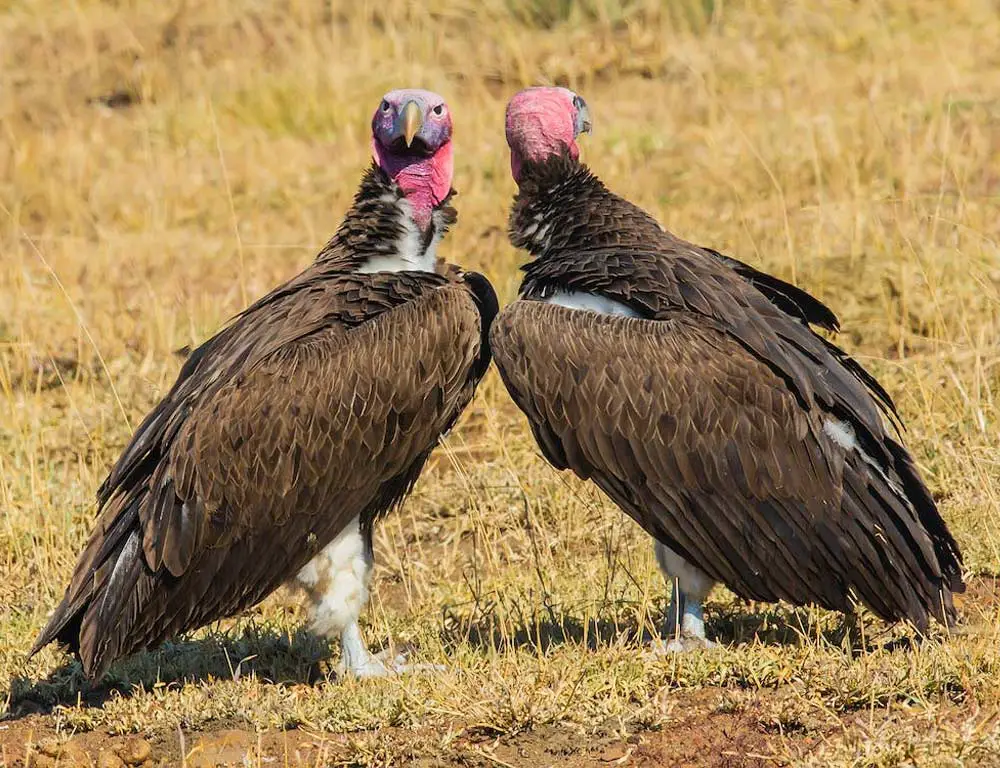
Vultures found in Texas, specifically the Turkey Vulture (Cathartes aura) and the Black Vulture (Coragyps atratus), share several common characteristics:
Feeding Habits
Vultures are scavengers and primarily feed on carrion (dead animals). They play a crucial ecological role by helping to clean up and recycle animal remains.
Appearance
Both Turkey Vultures and Black Vultures have distinctive bald heads and necks, which minimize contamination from bacteria found in carrion. Turkey Vultures have a redhead, while Black Vultures have a black head, making them easily distinguishable.
Flight
Vultures are large birds with long wingspans, allowing them to soar gracefully in the air. They use thermals and updrafts to cover large distances while searching for food.
Social Behavior
Vultures are often social birds and may gather in groups, especially when feeding. They exhibit communal roosting and feeding behaviors.
Silent Soaring
Vultures are known for their silent soaring. They often glide with their wings outstretched, using air currents to stay aloft for extended periods without flapping.
Carrion Detection
Vultures have a keen sense of smell, allowing them to detect the scent of carrion from high altitudes. Turkey Vultures, in particular, rely heavily on their olfactory abilities.
Nesting Habits
Vultures typically nest on the ground in secluded areas such as caves, cliffs, or dense vegetation. They may use a variety of materials for nest construction.
Migratory Behavior
While some vultures, like Turkey Vultures, are known for their long-distance migration, others, like Black Vultures, may exhibit more localized movements.
Non-Aggressive Behavior
Vultures are not aggressive predators. Instead, they rely on scavenging for their food. They are known to coexist with other vultures and scavengers while feeding peacefully.
Role in Ecosystem
Vultures contribute to ecosystem health by helping control disease spread through the efficient removal of carrion. Their scavenging behavior provides a natural and essential cleanup service.
Understanding these common characteristics provides insights into the ecological roles that vultures play in the ecosystems of Texas and underscores their importance in maintaining environmental balance.
Types of Vultures in Texas
In the vast skies of Texas, two prominent vulture species, the Black Vulture (Coragyps atratus) and the Turkey Vulture (Cathartes aura), gracefully patrol the landscape, embodying nature’s efficient scavengers.
These birds, with their distinct characteristics, play vital roles in maintaining ecological balance by contributing to the cleanup of carrion. Let’s delve into the unique features and lifestyles of these vulture species that soar above the Lone Star State.
Black Vulture (Coragyps atratus)
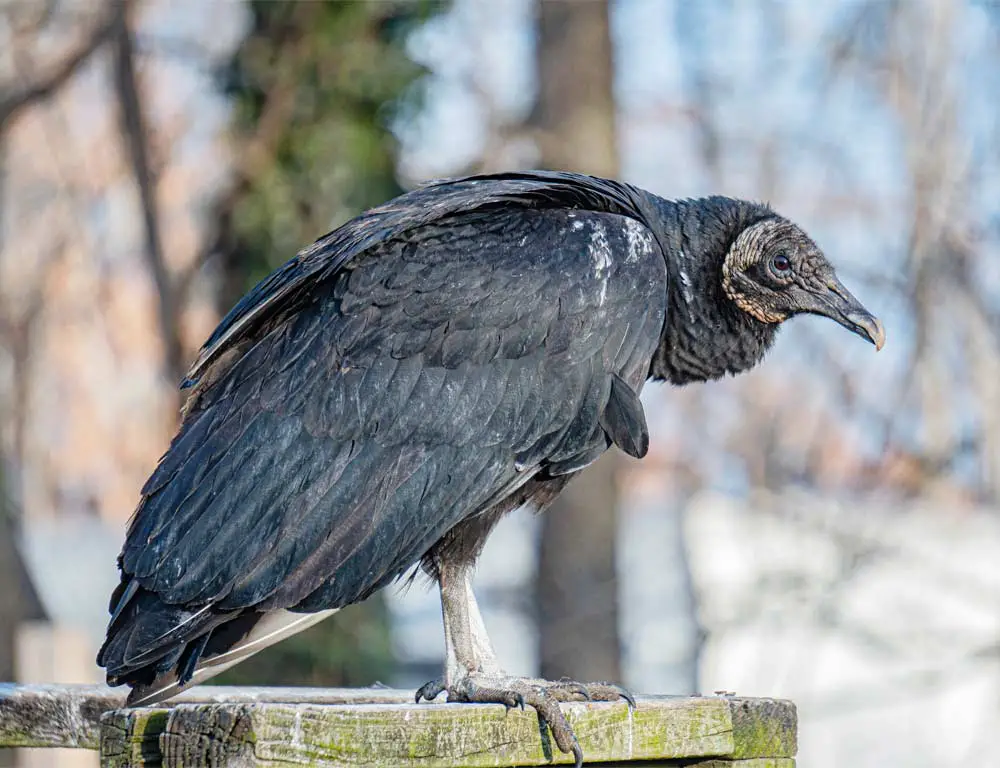
- Scientific Name: Coragyps atratus
- Population: Black Vultures are relatively abundant in Texas, with a population that varies across regions.
- Life Span: Black Vultures can live up to 10 to 15 years in the wild.
- Size: Adults have a length of about 22 inches and a wingspan of approximately 54 inches.
- Weight: They weigh around 3 to 5 pounds.
- Food: Black Vultures primarily feed on carrion, often relying on Turkey Vultures to locate carcasses.
- Wingspan: Their wingspan is approximately 54 inches.
- Status: Black Vultures are not currently listed as threatened or endangered.
Black Vultures are easily identified by their black plumage and short, square tails. Social birds often form large groups, exhibiting a communal roosting behavior.
While lacking a sense of smell, Black Vultures compensate by following Turkey Vultures to locate food. Their feeding habits include scavenging on various carriers, contributing significantly to the ecosystem’s cleanup process.
Turkey Vulture (Cathartes aura)
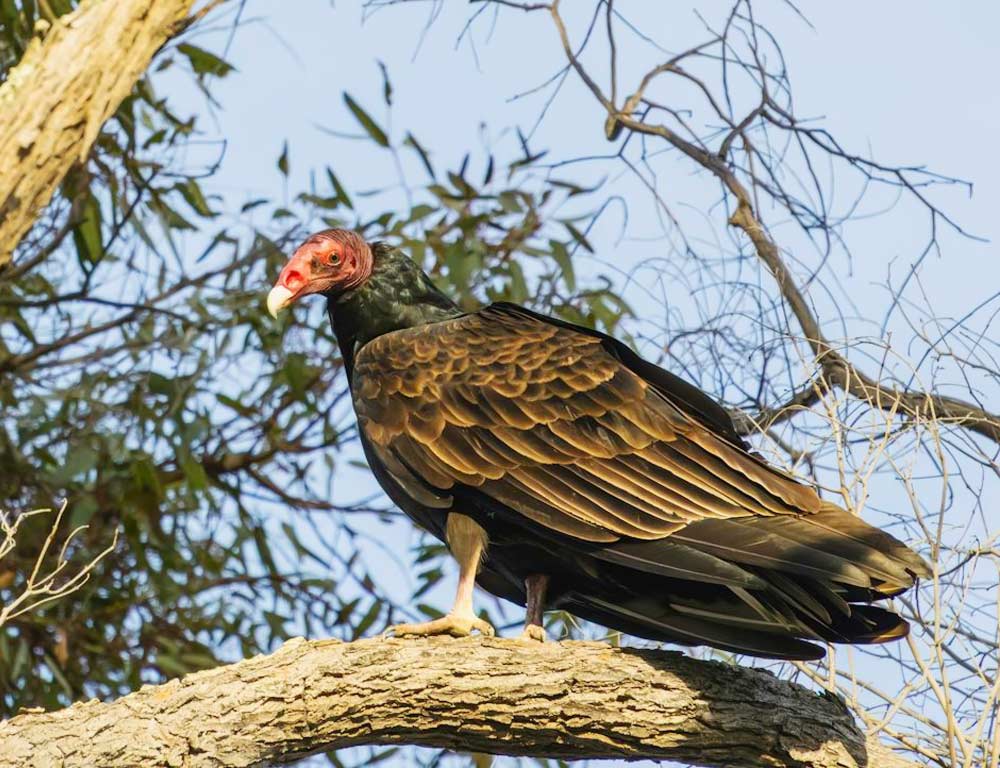
- Scientific Name: Cathartes aura
- Population: Turkey Vultures are widespread and relatively common in Texas, adapting to various habitats.
- Life Span: Turkey Vultures can live up to 20 years or more in the wild.
- Size: Adults have a length of about 25 inches and a wingspan ranging from 63 to 72 inches.
- Weight: They weigh around 4 to 5.5 pounds.
- Food: Turkey Vultures primarily feed on carrion, relying on their keen sense of smell to detect decaying flesh.
- Wingspan: Their wingspan ranges from 63 to 72 inches.
- Status: Turkey’s Vultures are not currently listed as threatened or endangered.
Turkey Vultures are recognizable by their red heads, featherless faces, and distinct soaring flight patterns. These vultures rely heavily on their sense of smell to locate carrion, distinguishing them from other vulture species.
Known for their migratory behaviors, Turkey Vultures demonstrate adaptability to various habitats, including forests, open fields, and urban areas.
Their efficient scavenging is crucial in maintaining ecological health, underscoring their significance in Texas’s diverse ecosystems.
Preservation Steps for Vultures in Texas
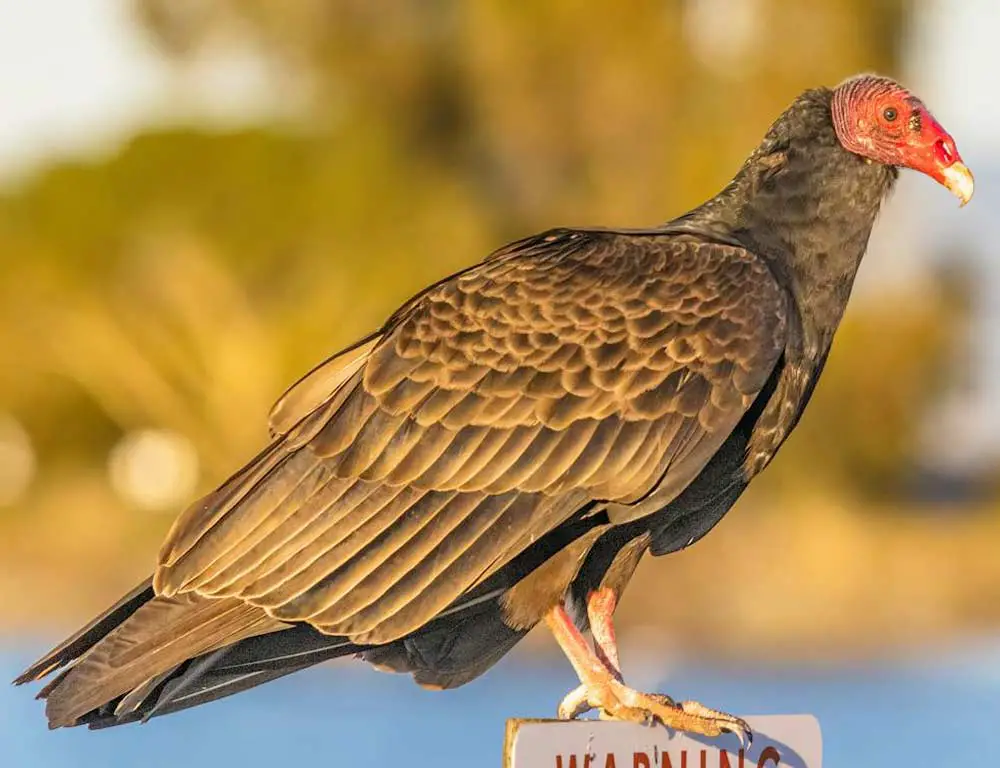
Preserving vultures in Texas is essential for maintaining ecological balance and ensuring these scavengers’ vital role in the ecosystem. Here are six elaborative steps for the preservation of vultures in Texas:
Habitat Conservation
Protect and conserve vultures’ diverse habitats, including open landscapes, forests, and urban areas. Preserve nesting sites, roosting areas, and foraging grounds to ensure vultures can access suitable environments.
Minimize Lead Exposure
Implement measures to reduce lead exposure, a significant threat to vultures. Lead poisoning can occur when vultures ingest lead fragments from spent lead ammunition in carcasses.
Encourage the use of non-lead ammunition and educate hunters and wildlife enthusiasts about its benefits.
Mitigate Collisions
Address collision risks by raising awareness about the dangers of wind turbines, power lines, and other structures.
Collaborate with energy companies and conservation organizations to implement strategies that minimize the impact of such structures on vulture populations.
Anti-Poisoning Campaigns
Conduct public awareness campaigns to discourage the use of poison baits, which can unintentionally harm vultures.
Promote alternative methods for pest control and educate communities about the dangers of poisoning, emphasizing the ecological importance of vultures.
Community Education
Foster community engagement through educational programs, workshops, and outreach initiatives.
Educate the public about the ecological role of vultures in maintaining a clean environment by efficiently recycling carrion. Encourage responsible waste disposal practices to reduce the reliance on vultures for waste cleanup.
Monitoring and Research
Support ongoing monitoring programs and research efforts to gather data on vulture populations, behavior, and health.
This information is crucial for identifying emerging threats, understanding migration patterns, and implementing targeted conservation strategies.
Legal Protection and Policies
Advocate for and enforce legal protections for vultures at the state and federal levels.
Collaborate with policymakers to establish and strengthen regulations safeguarding vultures from direct harm, habitat destruction, and other anthropogenic threats.
Preserving vultures in Texas requires a multi-faceted approach addressing direct and indirect threats.
Through habitat conservation, education, and collaborative efforts, it is possible to secure the future of vultures in the state, ensuring they continue contributing to the ecological balance and well-being of Texas ecosystems.
Wrapping Up
In the vast landscapes of Texas, preserving vultures is a testament to our commitment to maintaining ecological harmony.
By implementing conservation strategies, addressing threats, and fostering community awareness, we can secure a future where these vital scavengers continue to play their crucial role in nature.
From habitat protection to mitigating human-induced risks, our collective efforts can ensure the skies above Texas remain graced by the presence of these essential birds, contributing to a balanced and thriving ecosystem.